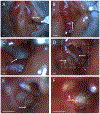In vivo Calcium Imaging of Mouse Geniculate Ganglion Neuron Responses to Taste Stimuli
- PMID: 33645563
- PMCID: PMC8048314
- DOI: 10.3791/62172
In vivo Calcium Imaging of Mouse Geniculate Ganglion Neuron Responses to Taste Stimuli
Abstract
Within the last ten years, advances in genetically encoded calcium indicators (GECIs) have promoted a revolution in in vivo functional imaging. Using calcium as a proxy for neuronal activity, these techniques provide a way to monitor the responses of individual cells within large neuronal ensembles to a variety of stimuli in real time. We, and others, have applied these techniques to image the responses of individual geniculate ganglion neurons to taste stimuli applied to the tongues of live anesthetized mice. The geniculate ganglion is comprised of the cell bodies of gustatory neurons innervating the anterior tongue and palate as well as some somatosensory neurons innervating the pinna of the ear. Imaging the taste-evoked responses of individual geniculate ganglion neurons with GCaMP has provided important information about the tuning profiles of these neurons in wild-type mice as well as a way to detect peripheral taste miswiring phenotypes in genetically manipulated mice. Here we demonstrate the surgical procedure to expose the geniculate ganglion, GCaMP fluorescence image acquisition, initial steps for data analysis, and troubleshooting. This technique can be used with transgenically encoded GCaMP, or with AAV-mediated GCaMP expression, and can be modified to image particular genetic subsets of interest (i.e., Cre-mediated GCaMP expression). Overall, in vivo calcium imaging of geniculate ganglion neurons is a powerful technique for monitoring the activity of peripheral gustatory neurons and provides complementary information to more traditional whole-nerve chorda tympani recordings or taste behavior assays.
Conflict of interest statement
The authors have no conflict of interest to report.
Figures


References
-
- Chandrashekar J, Hoon MA, Ryba NJ & Zuker CS The receptors and cells for mammalian taste. Nature. 444 (7117), 288–294, (2006). - PubMed
Publication types
MeSH terms
Substances
Grants and funding
LinkOut - more resources
Full Text Sources
Other Literature Sources
